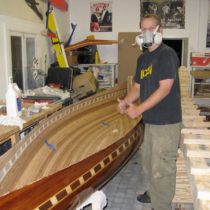Landscape Architecture for Landscape Architects › Forums › PLACES & SPACES › Dutch ideas about traffic
- This topic has 1 reply, 5 voices, and was last updated 14 years, 4 months ago by
 Maja Simoneti.
Maja Simoneti.
-
AuthorPosts
-
December 4, 2009 at 12:01 am #172111
 Roland BeinertParticipant
Roland BeinertParticipantTake a look at this article: http://www.hamilton-baillie.co.uk/_files/_publications/17-1.pdf
I’m starting this discussion after having a long drawn out argument about this topic in another discussion. What do you think? Do the ideas in the article have some merit or not?December 4, 2009 at 5:34 am #172132 Maja SimonetiParticipant
Maja SimonetiParticipantCouldn’t agree more. It is difficult to understand why something so reasonable is not used on regular base. Why all this big fuzz with either removing all the cars or securing safety with new traffic lanes for bikers and pedestrian and making everyday life so difficult and open space so unpelasetn to stay in? I gues it is how far the majority of people and decision makers came by now, At least in Slovenia also the fact that traffic planners are quite traditional in the perspective is the fact.
December 4, 2009 at 2:57 pm #172131 Ben YahrParticipant
Ben YahrParticipantThat is an excellent article. I briefly looked at Houten, Netherlands (the city mentioned as having a successful pedestrian/auto separation) on Google Earth. The separate bike and auto routes are very interesting, but it seems like more of a novelty than an effective way to design a city.
I can see the advantages to separate transportation ways, but I don’t see how it could be feasible in anything except a newly constructed “city” like Houten. We would be much better off retrofitting existing cities with home zones, woonerfs, and other similar concepts that force drivers to acknowledge other forms of transportation rather than zipping by happily on their dedicated lanes.
One challenge that I can see is selling these ideas to regulators. Can you imagine standing up at a city council meeting and telling a skeptical crowd- “this woonerf will work because the only way to make an intersection safe is to make it more dangerous”.
The other question I have is the scale at which these types of improvements are feasible, and where they could be incorporated into the typical sprawled out American city. Residential and downtown areas seem like a great starting point, but what do we do about the unfortunate disconnect that typically fractures our cities? One part of me would like to say that we should focus all of our attention on revitalizing urban centers and letting the suburbs fizzle out, but another part of me would like to see a concept for a “pedestrian/bike revolution” of the suburbs. Is it possible or is the scale just completely wrong?
December 5, 2009 at 12:09 am #172130 Trace OneParticipant
Trace OneParticipanti like the idea that the ‘natural’ speed for humans is 20 mph – that would save a lot of gas..But I just hate this shared space stuff – could not link to the article Roland was siting, so read Salon interview, “why don’t we do it in the road..” The final insult, I think, is ‘shared space’ probably saves the developer tons of money..
But I want kids in the streets, safe by a separated grade-changed, barriered space, and able to bike to the store at night, at all speeds..This cow-towing to vehicles has got to stop..Shared space to me is a developers answer..I don’t even like round-abouts..I do like the four-way stop – that necessitates a lot of interaction to negotiate..
Like I said before, the bikers are actually against separated lanes, at any speed, and fighting separation..obstructing it..December 5, 2009 at 12:17 am #172129 Roland BeinertParticipant
Roland BeinertParticipantAs the article pointed out, it is unfortunate that traffic planners aren’t trained along with other design professionals. I think that would help.
December 5, 2009 at 12:21 am #172128 Roland BeinertParticipant
Roland BeinertParticipantYou’re right that it is a tough sell. I think it will take a few really good projects in the US before the idea begins to catch on. There are only a few now in the US, and they are really just one or two streets or portions of streets in a few cities.
I guess what you’re getting at is that this is more of a local solution to traffic at the scale of individual neighborhoods. It certainly won’t do anything about the disconnect of one neighborhood to another. It will take massive changes in zoning and attitudes to deal with the fractured nature of our cities.
I have no idea what will happen to the suburbs. I suspect if gas prices go up again soon, some, maybe all, would die out. Some might eventually become part of development along rail lines if we ever decide to revitalise rail travel. Maybe some would go back to being farmland, too. I think it depends on the individual suburbs and their relation to the rest of the city, their mixture of uses, and how attached the residents are to the place. I’m sure some of them could have a pedestrian/bike revolution.
I think Dutch cities and Europe, in general, are a good model for pedestrian and bike-friendly development, even if we don’t follow it exactly. They seem to have an overall strategy to keep cars from overwhelming them, and shared use areas are just one part of it.December 5, 2009 at 2:00 am #172127 Roland BeinertParticipant
Roland BeinertParticipantTrace, based on everything you’ve said here and in the other discussion, I think you are confusing the general lack of sidewalks and bike lanes in the US with the concept of shared space from the Netherlands. Developers in the US don’t use shared space as an excuse to not put in sidewalks and bike lanes, especially since most of them have never even heard of shared space. Even if they had heard of it, they would probably dislike the idea and agree with you about separation being better (and then still not put in bike lanes and sidewalks). They don’t include them because they don’t want to spend the money, and they don’t think anyone will want to walk or bike. There is a huge difference between a shared space in the Netherlands and the 50 foot wide streets with no sidewalk and bike lane found in the US suburbs.
Like a lot of people, you have a very warped view of bicyclists. I don’t know why they didn’t like your idea of bike lanes. If it makes any difference, I apologise on behalf of all bicyclists. I want a safe, interconnected network to bike on, that will get me anywhere a car will. I think the only point we disagree on is whether shared spaces can be a part of that network. Let’s just agree to disagree.December 5, 2009 at 1:25 pm #172126 Trace OneParticipant
Trace OneParticipantRJoland, I have been in planning, commercial site plan review for 20 years, and the concept of shared space has nothing to do with the 50 foot wide road in huge residential developments in the middle of nowhere …Please! More respect, please..In my experience in planning in virginia and new york, everyone has heard of woonerfs, (at least since I got my first planning job in 1991), and they love them.. In plan..there is nothing new to that idea, as you can see how it is institionalized in the Hamilton-Baille article..Institutionalized in Britain and Denmark, germany – it just isn’t new..
I think developers love them because the word just saves them money, right off the bat..As for warped view of cyclists, please listen or read about the LA canyon road rage against cyclists case – and read the comments made on the articles (on NPR< is a good one) and you will see intense amounts of anger and frustration on both sides….My view is simply that there IS conflict – not that bikers are wrong, just equally as guilty as cars.. I am not against bikers..I am just saying there IS a huge conflict, and secondly, a lot of bikers (including yourself, it seems?) have a huge attitude against separated lanes, they want bikes on the road..
I think they are fighitng against their own best interests, at a time when we possibly could get some really outrageious bike lanes, for obvious reasons – TARP money, green initiatives..December 5, 2009 at 8:47 pm #172125 Roland BeinertParticipant
Roland BeinertParticipantI’ve heard of only a few projects in the US, and see no evidence they are being over-used. I’ve never lived in New York or Virginia, so maybe they are used there a lot and just aren’t widely known about in the midwest and west. Can you name a few of these projects in New York or Virginia and point to articles where residents say they hate the woonerf? Or where there have been a lot of fatalities on these streets because of the woonerf treatment?
I see absolutely no evidence whatsoever to support the idea that shared space is “a developer’s answer” as you called it. From all I’ve read, I get the impression that some are more expensive (especially retrofits) and some are less expensive. That’s why I got the impression you are mistaking it with something else. No offense. There were no developers involved in coming up with the concept, and people in the Netherlands, Germany and Britain like the idea. In the UK, the “home zones” (UK’s version of the woonerf) are supported by the Children’s Play Council. I’m fine if you disagree with the concept in general, but don’t particularly like it when you misrepresent the idea as something developers do to weasel out of spending more money. Did I misunderstand you?
It is a good point that this may be a good time to build more bike lanes. I’m all for it.December 6, 2009 at 9:44 pm #172124 Roland BeinertParticipant
Roland BeinertParticipantTo summarize my rant about your last reply, I guess I just don’t get what you’re talking about when you say shared space is a “developer’s answer”. Monderman did not come up with the idea to benefit developers in any way. And the original woonerf concept is more to do with allowing streets to be public space FOR RESIDENTS than anything. How do developers benefit from more public space more than residents do?
It occurs to me that we are arguing this in a very black and white way, as if it’s separation vs. shared space, all or nothing. I don’t think that’s really how they view it in the Netherlands. Over there they are just using the right method in the right spot whether it’s separation or shared space. Shared space is just one small part of an overall strategy that has allowed Dutch cities to be some of the safest in the world for pedestrians and bicyclists. They use plenty of other strategies including separated bike lanes, streets that are one way for cars and two ways for bicyclists, bike paths through green space, plenty of bike parking, etc. That’s ultimately what I would like in US cities. I’m not against separation. I just want well thought out bike/pedestrian plans for cities, and see shared space as one potential component of it.December 6, 2009 at 11:38 pm #172123 Trace OneParticipant
Trace OneParticipantI am not saying the woonerf was conceived by developers – I am saying it benefits developers by being cheaper..I agree – the right solution for the right space..But bicycle groups have taken the shared space concept to an extreme, to their own detriment, in my estimation..
I think every single developement i worked on, as a planner, in Southampton and Charlottesville, talked about using the’shared space’ concept..
I don’t like it at 10 mph, and don’t like it at 34 mmph.. I want to buck this trend..For me it is just like the rotary rage that is sweeping america..
I just can’t see sending your ten year old son out on shared streets to get some milk.. Now is the time to create a true bike infrastructure in america..
I also can’t see the kids playing in the subdivision on the street.. I hate that..Maybe it comes from haveing too many animals crushed..
Death statistics – I looked that up – China is not even on the list..So it seems like the list needs a lot of adjusting, just going on that alone..
Perhaps it had to do with American society – we are the only one of all the western nations without a national health system..Our society approves of competition. It does not approv of co-operation. (so far..) Perhaps we will grow into the woonerf – in a few decades, America will have no guns, lots of environmental regualltions on agriculture and clean air and water, and safe streets for kids to play in..
It was interesting that over 30% of pedestrian traffic fatalities are old people..Don’t know where to go with that, how that relates to the woonerf..
Why are you so invested in the woonerf? It is an idea that has enamoured your mind, apparently..I like to look beond established wisdom…and in fighting the ucsd bikers, I had a really bad experience.. We had money for separated lanes..They DID NOT WANT them, at any speed..Go figure.. (ps, you can look up the fight for on-the-road biking vs. separated space on any major biking page, or at least you could two years ago – there is reams of argument going on, over this issue..)
Did you see Boulder’s reverse flow bike lanes? Very cool..December 7, 2009 at 6:41 am #172122 BoilerplaterParticipant
BoilerplaterParticipantI wonder if the reason bikers want to be on streets is that it is perceived to be safer from potential assailants. That is, when you are on a bike path that is isolated or hidden from streets, are potential attackers, thieves, perverts etc. more likely to be there? At least if you are along a road, you are more likely to be seen if you’ve been injured or attacked. I worked on a path for the D&R canal State Park in NJ. Most of the path is very popular, running along a historic canal. Its used by joggers, bycyclists, dog walkers. The part I worked on, which was a final connection in the system, goes hrough rather depressed sections of the City of Trenton. The few miles in the city get very little use by bikers and are more trash strewn. Residents of nearby areas use it as a footpath. I rode on it a few times with out incident, but I’m a 6′ male. I wouldn’t recommend it to people who are easily intimidated.
Speaking of Woonerfs, I’ve been to Holland several times as I had relatives there. I’ve known people who lived near wonerfs so I experienced them firsthand. The thing that is worth nothing is that the traffic volume is so low that I would not be concerned about kids playing in one. Of course, drivers look out for bikes there so much more. Its so much a part of the culture. You’ll see parents toting kids to school in a bike seat regularly. When I visited my grandparents when I was 10, they rented a bike for me and let me loose on the town. I had the best time! Looking back on it, its somewhat amazing that they would think I would be safe in an unfamiliar town where I could only speak a few words in Dutch. That takes in enormous amount of faith in one’s fellow burghers. Bike lanes are commonly separated, but they are close to roads. I think in a way kids there have a lot more personal freedom due to bike safety. One of the more remarkable things I saw was a kid on a bike pulling a trailer loaded with a wind surfboard. He was on a path miles from the nearest beach. His whole recreational outing, from getting there to enjoying it, would be carbon free!
I tried to promote this kind of thing a bit when I worked for the NJDOT, but the reaction I got was basically like, “Well, our mission is to decide what to plant around the highways. Why should we do anything different?” And landscape architects wonder why their viewpoint is so marginalized. Yeah, I’ve experienced a string of disillusioning events in my LA career!
December 7, 2009 at 11:37 am #172121 Trace OneParticipant
Trace OneParticipantI agree about the DOT’s ! Man, I don’t even call them Landscape ARch’s, just to annoy them, I call them landscrapers and decorators (it helps to be a civil servant..hopefully won’t get fired..!)
But in commercial developments, the parking lot/plaza concept, everyone does it, usualls saves some requirement for parking spaces..on paper looks lovely..in realitly, is the same parking lot for WalMart, just with bollards instead of sidewalks..
Sorry, Roland, I do like to ‘discuss’..
December 7, 2009 at 4:04 pm #172120 Ben YahrParticipant
Ben YahrParticipantAre there two separate arguments going on here- new development versus retrofits?
It seems to me that in retrofits a shared space concept would be much more feasible than somehow reallocating separate corridors specifically for one transit type or another.
But in new development, we have the chance to allocate and build right the first time around. Maybe we should be concerned with separate bike and rail corridors in addition to traditional roads. On the other hand, we have the opportunity to influence preference by offering choices, safe shared spaces, increased density, multiuse development etc. This seems like the perfect time to introduce home zones and extremely slow speed limits to increase awareness and the appeal of cycling or walking rather than zipping by happily on a separated road where bikers are never visible.
In order for any “alternative” transportation concept to take off, it has to respond to people’s needs. Is it possible to provide separated networks of bike paths to and from work areas, homes, grocery stores and entertainment; or is it more feasible to make existing networks between these areas safe and appealing to cyclists and pedestrians?
December 7, 2009 at 8:46 pm #172119 Roland BeinertParticipant
Roland BeinertParticipantTrace,
I do like the idea of the woonerf (I did my senior capstone on it), but I’m mainly just defending the idea against you in this case (you did start this argument in that discussion about progressive urbanism, not me). Why should every street have to give priority to cars? The woonerf is less about moving cars (or bikes or pedestrians) around and more about social space. I like that idea. I wouldn’t defend it if I’d read anything that led me to believe they are dangerous. Everything I’ve seen has led me to believe they are safer than other residential streets.
I couldn’t find anything about the reverse flow bike lanes. -
AuthorPosts
- You must be logged in to reply to this topic.

